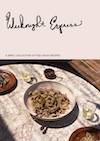These scones are inspired by a small Rangpur lime tree I planted in a terracotta pot on our patio. The tree came in the mail, kind of twig-like in a long box, and arrived about four years ago. The harvests are small, but the limes are exquisite, so I like to make everything I do with them count. And *this* is their season – my Rangpur limes are bright orange and ready to be used. I carefully snipped a few from the branches this morning, used a peeler to strip the zest, then squeezed every drop of juice I could. The whole kitchen was perfumed. I baked them into these buttery, golden, citrus-flecked scones. You can substitute a blend of orange and lime.
A few scone basics:
The foundation of a great scone is a good recipe and cold ingredients. The cold ingredients will make the dough much easier to work with. Avoid overworking the dough, and allow your scones to bake long enough to take on a good amount of color i.e. flavor. No pale scones please.
Rangpur Lime Scones: The Ingredients
A few words about the ingredients I use here and why. Along with substitution ideas.
- Flours: Like many of the scones I bake, this one uses a blend of two flours – all-purpose and whole wheat. While most scone recipes use all-purpose flour exclusively, I find that adding a percentage of whole wheat flour is really nice, adding dimension and rustic farmhouse baking vibes. All-white scones often end up tasting too one-dimensional to me now.
- Buttermilk: The buttermilk brings the tenderness and hint of tang. I use it as the backbone of most of the scones I bake.
- Sugar: These scones straight from the oven are just sweet enough. Not at all hot on the sugar front. The icing icing is another story, adding an intense layer of sweetness, but you can opt out. Scenario one: stop at the egg wash step for the least sweet version of this scone. Scenario two: sprinkle with large-grain sugar before baking (after the egg wash) for some satisfying sugary crunch with each bite. Or do a mixed bake.
- Rangpur Lime: You likely don’t have access to Rangpur limes, that’s ok. You can use a blend of 2 parts orange and 1 part lime as a substitute. I have the Rangpur lime tree on my patio, so I suspect I’m one of the few people who have access to *actual* Rangpur limes. Seek them out, buy a tree if you’re in the appropriate zone! I love the flavor – floral, sharp and sour, a hint smoky. They’re not technically limes, but a hybrid between citron and mandarin, but they taste more sour than that to me. I love making ponzu with the juice, and never waste any of the zest as you can see with the scones. Zingerman’s called them the Darling of Citrus, and I bought my little tree from Four Winds Growers.


Variations:
The recipe below is for the iced Rangpur Lime Scones. But here are a few other tweaks and ideas:
- Sugar-topped: As I mentioned up above, the recipe highlights the iced version of these scones, but there are times I like to bake a mixed basket, especially if I bake a double batch. If you would like to have a sugar top, before baking, brush with egg wash and then sprinkle generously with large-grain sugar. Another option: you can keep it very simple (photo below) and just do the egg wash before baking. In both these cases I’d double up on the zest in the scone dough.

These are both great options because you can enjoy the scones warm from the oven, while the iced scones need to cool before icing. Both are delicious!
- Dates: These scones are great with a big handful of pitted, chopped dates added to the wet ingredients. Or even better – boozy-soaked dates. A favorite holiday version.
- Poppy seeds: add 1/3 cup to dry ingredients.
- Crystalized ginger: adds jolts of chewy ginger sugar. Chop it small and add it along with the wet ingredients.
- Toasted pecans or almonds: be sure they’ve cooled completely. (Add to dry ingredients)

Making Lime Scones (Video)
Making Lime Scones By Hand
The recipe below assumes you have an electric mixer with a paddle attachment, but making them by hand is also possible and will save you some dishes! To make these scones by hand reference these instructions:
- Start with the dry ingredients: Mix the dry ingredients well and then turn out into a pile on your counter top. Sprinkle the cold butter across the flour mixture and use your hands to rub the butter into the flour until it is evenly distributed throughout. You can use a dough scraper (or pastry cutter) to chop through the pile a bit and break up any butter lumps. Work quickly, you want the mixture to be sandy, with tiny pebbles.
- Add wet ingredients: Wrangle the flour mixture back into a pile with a dough scraper and make a well in the middle (the way you do when making homemade pasta). Pour the wet ingredients into the well and use your dough scraper to fold and mix the flour into the wet ingredients. Keep going until there is no dry flour left and a dough has started to form. It should look like this (below) minus the mixing bowl.

- Shape: Gather the dough into a ball and proceed with the recipe as written – slicing the dough into wedges and so forth.


I like to serve these scones with special compound butters and a bit of honey or marmalade. The butter you see below is salted and mixed with more citrus zest. And that’s a honeysuckle jelly off to the side that I think I picked up at Elder Flat Farm Store in Los Alamos, Ca. You can’t go wrong with a honey butter, or spicy hot honey butter.
A mixed basket of scones is pictured below. Some with icing, others without. Once the icing sets you don’t have to worry about it smearing. It was cold this morning so it set quickly, in 30 minutes or so, but other days might take longer.



